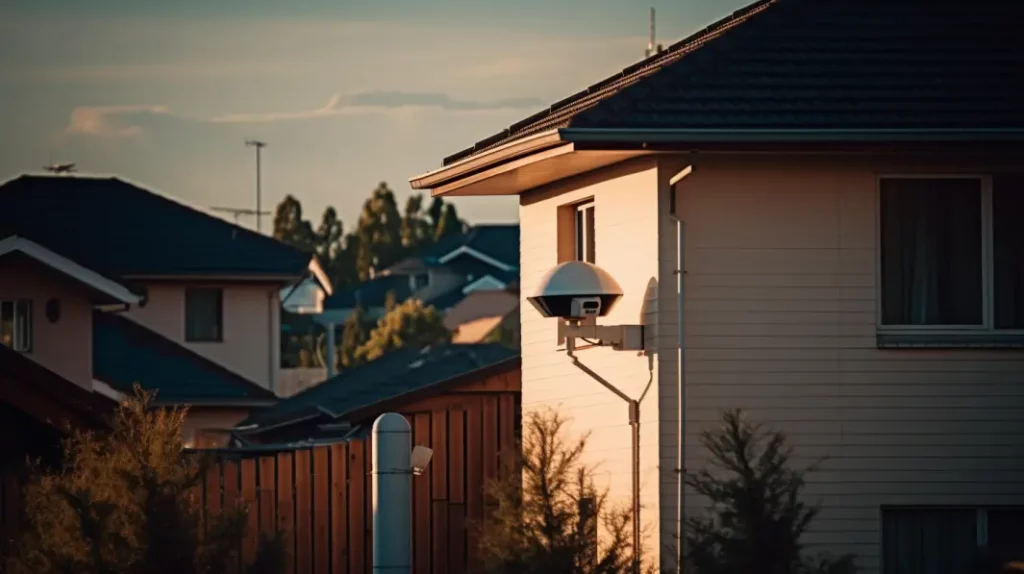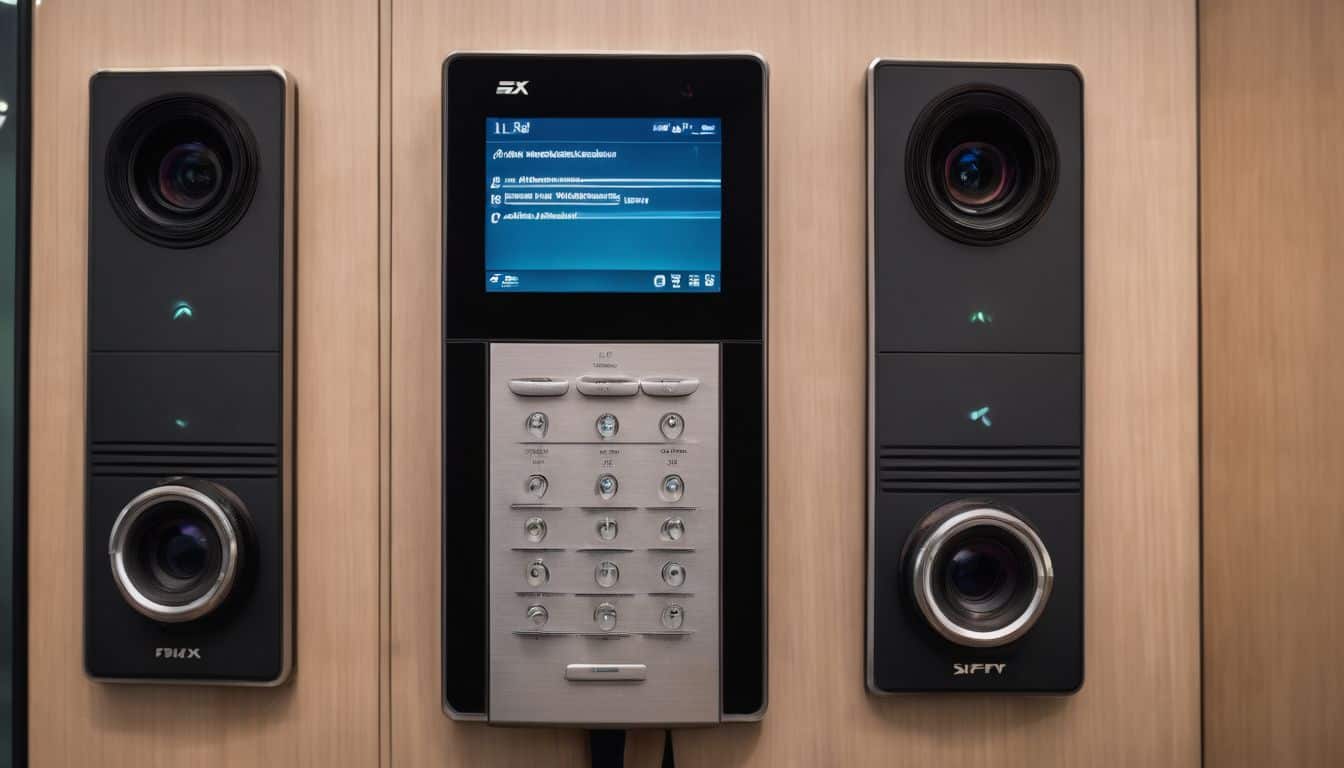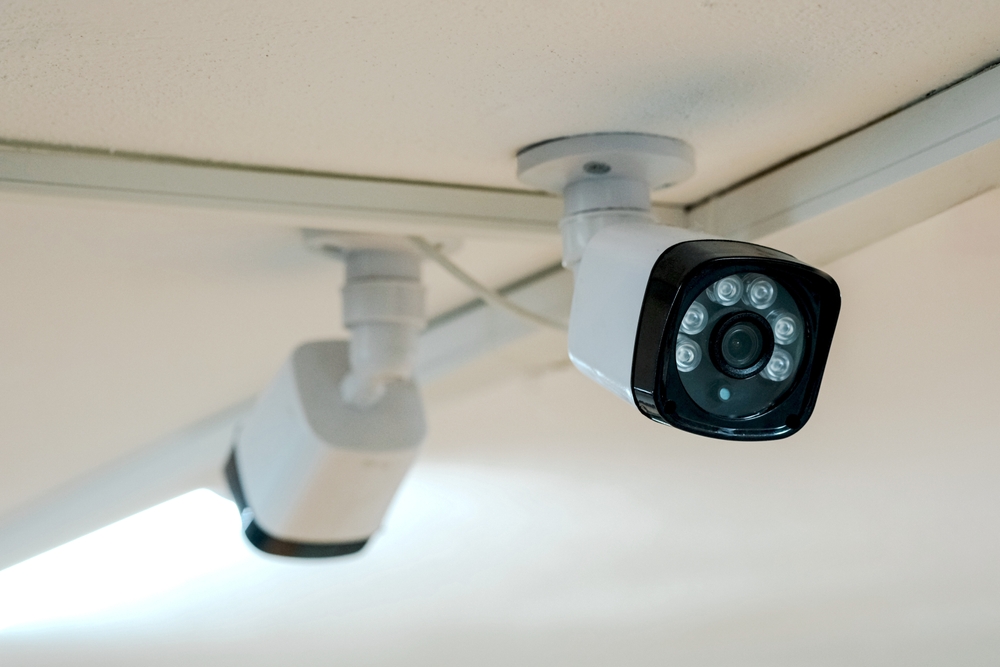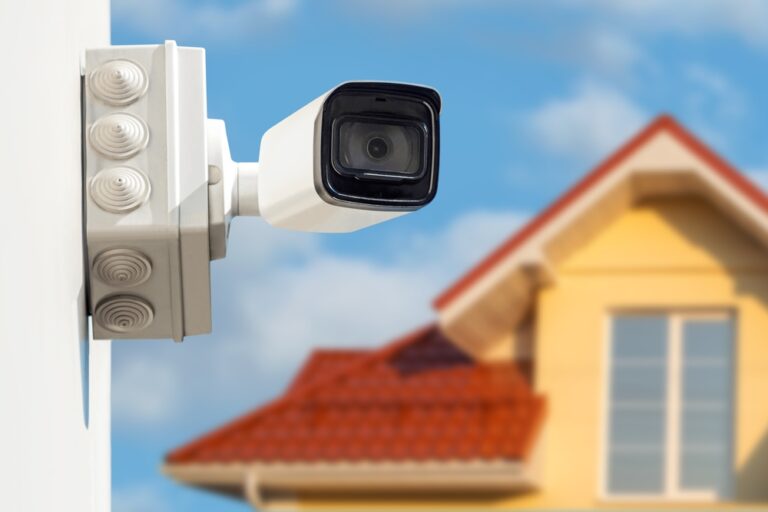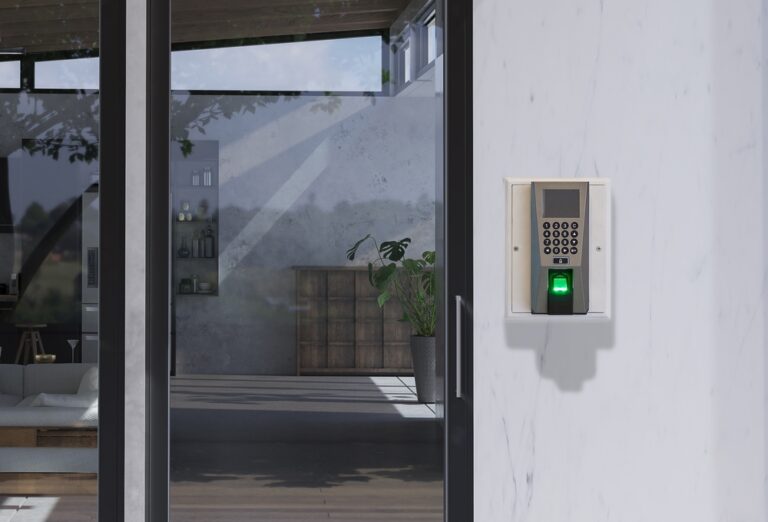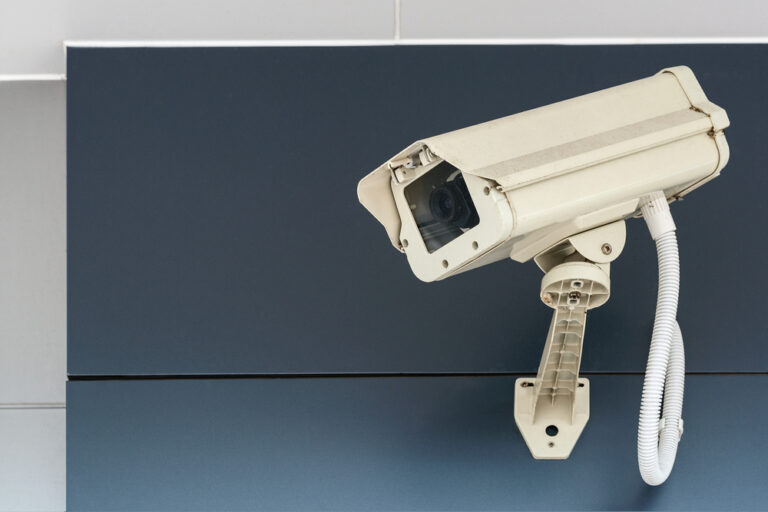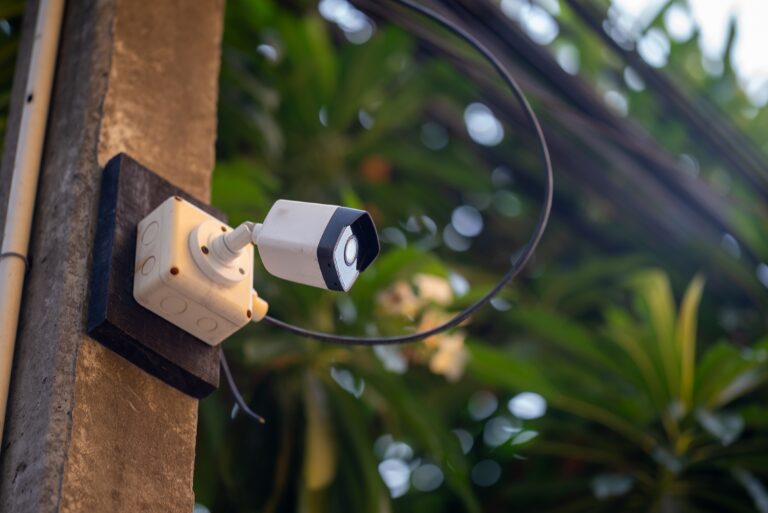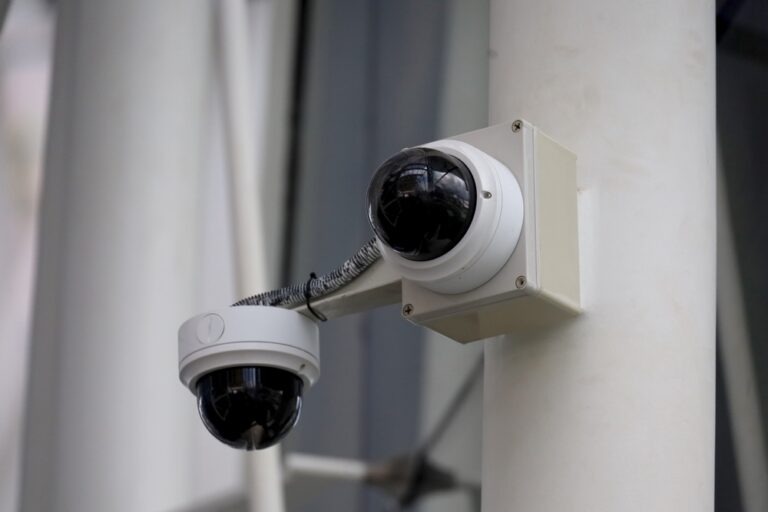- 1) Introduction
- 2) The Importance of Intercom Systems for Home and Business Security
- 3) Types of Intercom Systems
- 4) Choosing the Best Intercom Installation Services
- 5) Integrating Intercom Systems with Security Cameras
- 6) Wired vs. Wireless Intercom Systems
- 7) Telephone Entry Systems and Door Buzzer Systems
- 8) How to Choose the Right Intercom System for Your Needs
- 9) Conclusion: An Effective Duo for Securing Properties – Intercoms and Cameras
- 10) FAQs
Introduction
Intercom and security camera systems are vital technologies for monitoring access control and enhancing safety and security in both homes and businesses. When properly integrated, intercoms and video surveillance cameras provide a powerful combined solution for managing visitors and tracking activity on your property.
| Key Takeaways |
|---|
| Intercom stations enable visitor screening and access control while IP cameras capture identifying visuals of events |
| Combining intercom communications with high-def surveillance footage cements protective oversight of entry points |
| Video intercoms allow convenient visual verification of guests before engaging in discussions or enabling remote unlocking |
| Wired intercoms facilitate feature-rich access control integrations while wireless suits retrofits |
| Selecting intercom systems factors in entry types, usage volumes, expandability, and connectivity methods |
An intercom allows two-way communication with visitors at entry points to screen individuals before granting access. Intercoms enable remote entry control and instant voice contact without physically going to the door.
Security cameras provide the visual component for identifying and recording video of all ingress activity. High-definition cameras capture clear video evidence day or night.
Together, a state-of-the-art IP intercom system integrated with megapixel surveillance cameras gives homeowners and business owners complete visibility and control over their property’s access points.
This guide will cover the key considerations around choosing, installing and configuring intercoms and security cameras for seamless operation. We’ll look at:
- The importance of intercom systems
- Intercom system types
- Factors for selecting top intercom installation services
- Integrating intercoms with video surveillance systems
- Wired vs wireless intercom systems
- Telephone entry and door buzzer systems
- Additional features like access control and video analytics
- How to choose the right intercom-camera solution for your needs
Properly setting up and integrating a robust intercom-camera system brings multifaceted property access control, contacts screening, real-time monitoring, and video verification for responding to incidents.
The Importance of Intercom Systems for Home and Business Security
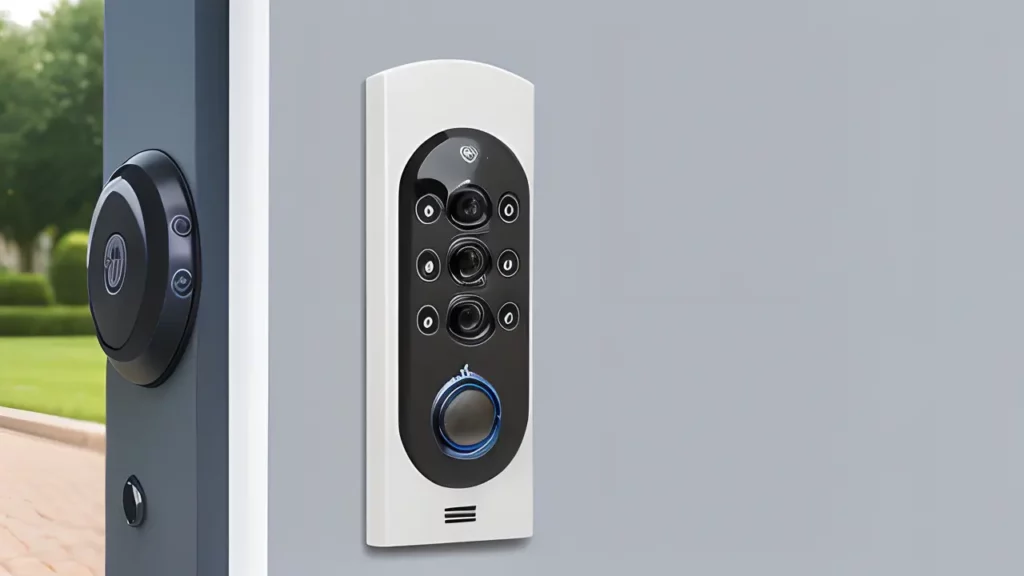
Intercom systems play a vital role in property access control and enhancing safety for both residential and commercial settings. Intercoms allow screening visitors before allowing entry while providing two-way voice communication. This gives homeowners and business owners more control over who gains access to their building.
Screening Visitors and Granting Entry Remotely
- With an intercom, you can speak to visitors to verify their identity and reason for visit from anywhere on the premises without physically going to the door.
- Built-in audio intercom stations enable clear two-way talking using room speakers and sensitive microphones.
- Touchscreen video intercom panels even allow visually inspecting visitors with high-def cameras before deciding whether to grant access via remote door unlocking. This screening ability acts as an initial perimeter safeguard to prevent unauthorized access.
Deterring Criminal Activity
- The presence of an externally visible intercom system acts as a deterrent to would-be trespassers or intruders.
- Signage warning of active surveillance and access screening conveys that illegal entry attempts carry a high risk of getting caught, stopping criminals in their tracks.
Rapid Communication and Alerts
- In case of a safety incident or suspicious activity, occupants can swiftly send an emergency alert to other stations through the use of built-in panic buttons.
- This enables rapid communication and response to dynamically lock down access points when faced with a security event.
Monitoring and Managing Visitor Activity
- Sophisticated intercom systems provide centralized oversight capabilities via desktop or smartphone to control visitor permissions and view access logs.
- This gives a convenient consolidated interface to manage and track all intercom activity 24/7.
- Intercom visitor management is indispensable for residential gated access as well as office building entry procedures.
- Keeping tight reins over ingress/egress activity is paramount for property protection.
Types of Intercom Systems
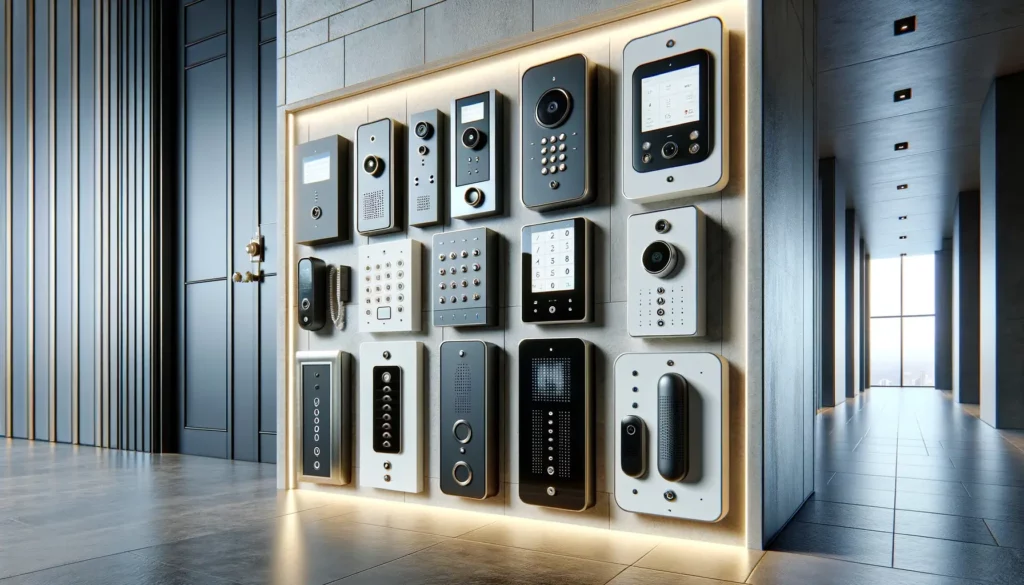
When considering intercoms, there are multiple categories and system configurations available. The right choice depends on your property type, entry points, and functionality needs. Below we cover the most common intercom system types and their core capabilities for access control and occupant communication.
Voice Intercom Systems
- Voice intercoms provide two-way audio communication between intercom stations using built-in speakers and microphones.
- They allow homeowners and office staff to talk to visitors to pre-screen them before permitting entry through locked doors.
- No visual identification is possible, but voice verification adds a preliminary screening layer before allowing access into secured entry points.
- Often connects to electric door strikes to enable remote entry control after voice screening.
- Simple and affordable option suitable for smaller buildings.
Video Intercom Systems
- Video intercom systems take access screening to the next level by incorporating outdoor IP video cameras into external intercom panel units.
- Touchscreen video panels give homeowners a look at who is at the door when the doorbell rings through a video feed displayed directly on the panel.
- This visual verification combines with two-way voice communication for true screening and instant entry approval.
- More expensive systems but provide complete and identifiable visitor monitoring.
Telephone Gate Intercom Systems
- Designed for use at gated property entrances to allow visitors and guests to call residents from their car-mounted intercoms.
- Visitors punch in a code on a keypad to connect to a user’s mobile phone. Homeowners can then talk to the guest via phone before hitting a remote switch to open the gate for entry.
- No need to run to the perimeter gate if occupied far into large property since calls route directly to owners’ cell phones.
Wireless Intercom Systems
- Wireless intercom systems provide flexible placement of external intercom stations and internal handset units since no physical wires connect them.
- External wireless stations mount on walls or posts using batteries or solar while transmitting signals to interior transceivers.
- Avoid the hassle and expense of drilling holes through finished walls. Ideal solution for adding intercom monitor points to finished homes.
Outdoor Intercom Systems
- Outdoor intercom stations feature weatherproof enclosures and components to withstand exposure to rain, wind, heat, and cold.
- Protects internal circuit boards, sensitive microphones, and speakers from moisture damage or corrosion.
- Steel vandal-resistant designs prevent forced entry by prying open the housing. Withstands physical abuse from vandals.
- Secures perimeter access points in all weather conditions over many years.
Electric Gate Intercom Systems
- Allows visitors at perimeter vehicle or pedestrian gates to communicate directly with homes for entry instead of needing a clicker or keycode.
- Integrates intercoms directly into electric slide gate openers or swing gate motor drives.
- After screening visitor via two-way voice or video feed, homeowner can hit a remote gate trigger switch to open the gate for visitor passage.
- Simplifies visitor entry approval for large properties with gated driveways and perimeter fencing.
Choosing the Best Intercom Installation Services
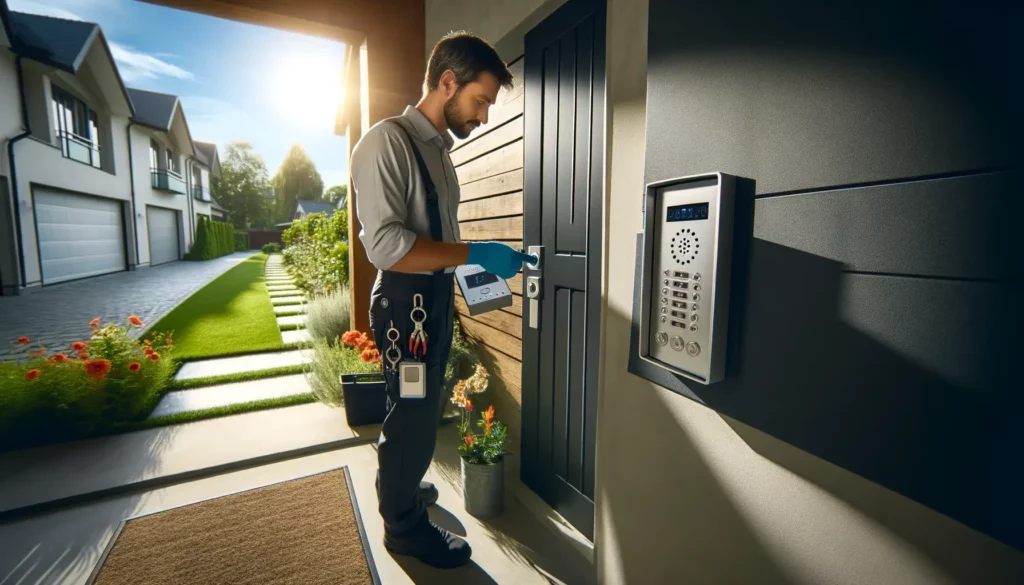
Choosing the right installation and support services is crucial for setting up and maintaining a customized intercom system for your property. Below are top criteria to evaluate when selecting an intercom integrator.
Trusted Intercom Brands
Partner with an integrator that represents top access control brands known for their quality and reliability, based on industry reputation and customer reviews. Brands like 2N, Axis Communications, Aiphone, Linear and Optex have widespread product adoption. Prioritize longevity and quality components that will work flawlessly when needed most.
Free Security Assessment
Look for complimentary on-site security evaluations of your property by qualified system designers to determine the optimal intercom system layout. A detailed site survey, needs analysis and solution briefing ensures an intercom and camera configuration matching your unique requirements.
Installation & Configuration
Choose certified technicians to handle the complete installation process including outdoor intercom positioning, interior equipment mounting, wiring and connections, device configuration, function testing, and end user orientation. Clean cable routing and programming for simplified system operation ensures long term reliability.
Maintenance & Support
Ongoing remote tech support and maintenance visits ensure your system stays in peak operating condition. Select a service provider that offers remote monitoring options, status alerts, firmware updates, optimizations and troubleshooting assistance via desktop or mobile apps for prompt issue resolution and remediation to maximize uptime.
For example, Jefferson Security Cameras has over 25 years of expertise designing and supporting integrated intercom and surveillance camera networks optimized for reliability and seamless functionality. Their experienced system consultants provide free site evaluations, equipment recommendations, professional installation, and ongoing support.
Integrating Intercom Systems with Security Cameras
Interfacing intercoms with IP-based megapixel security cameras creates a powerful unified access control and surveillance solution. Combining these technologies reinforces entry point management while enhancing perimeter visibility.
Benefits of Combining Technologies
- Intercom stations enable visitor screening with two-way voice or video communication before permitting access via remote entry control.
- Integrated security cameras provide continuous wide-area surveillance as well as closeup identification of visitors at entryways.
- Fuses convenient communications capabilities with visual verification and recording.
- Centralized interface manages intercom activity logging and camera footage review.
- Deter and document trespassers thwarted at access checkpoints.
How it Improves Surveillance
- High-definition security cameras capture clear facial and clothing details under all lighting conditions using low light or IR illumination.
- Integrated motion-based video recording ensures all intercom visitor activity automatically triggers attached camera video capture without needing human intervention.
- Recorded video clips are tagged with metadata like intercom station location, date/time, and access outcome.
- Built-in analytics like AI facial recognition can match visitor faces to databases of authorized or barred individuals.
- Intercom events can also automatically trigger other actions like lighting control, notifications, or security lockdown procedures according to predefined response rules.
- Integrating intercom systems with security cameras takes property access control to the next level.
Wired vs. Wireless Intercom Systems
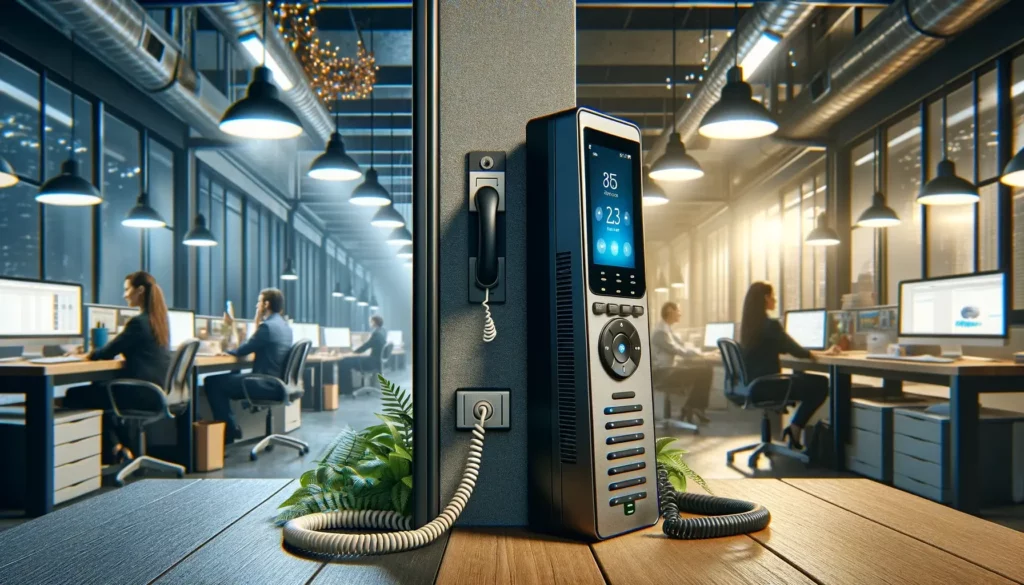
When selecting an intercom system, one of the key decisions is whether to implement a wired or wireless configuration. Below we outline the core advantages and limitations of each approach.
Wired Intercom Systems
Wired intercom systems use Ethernet cabling or low-voltage wires to interconnect entrance panels to interior monitoring equipment.
- Pros
- Provides reliable, high-bandwidth connections without signal interference
- Supports integration of access control locks, sensors and other systems via wired interfaces
- Often easier to expand by adding additional wired intercom stations
- Cons
- Installation requires drilling holes to route cables between intercom points
- More expensive hardware components and professional installation
- Entrance panels must mount close to access points to connect wires
- Difficult to add stations in finished buildings or remote locations
Wireless Intercom Systems
Wireless intercom systems leverage radio wireless connectivity between exterior intercom access points and interior handsets.
- Pros
- Flexible placement without wiring constraints
- Easy retrofits by mounting wireless intercom modules anywhere
- Avoid complex wiring jobs – uses battery or solar power
- Expandable by just adding wireless stations
- Often available as DIY installation kits
- Cons
- More limited range and potential wireless signal interference
- Lower bandwidth than wired intercoms
- Possible battery drainage issues over time
- Not always able to integrate advanced functionality like access control
The choice comes down to convenience vs. capabilities based on property layout, construction, budget and system requirements. Wired intercoms facilitate feature-rich installations while wireless suits retrofits. Consulting an integrator helps select the ideal option.
Telephone Entry Systems and Door Buzzer Systems
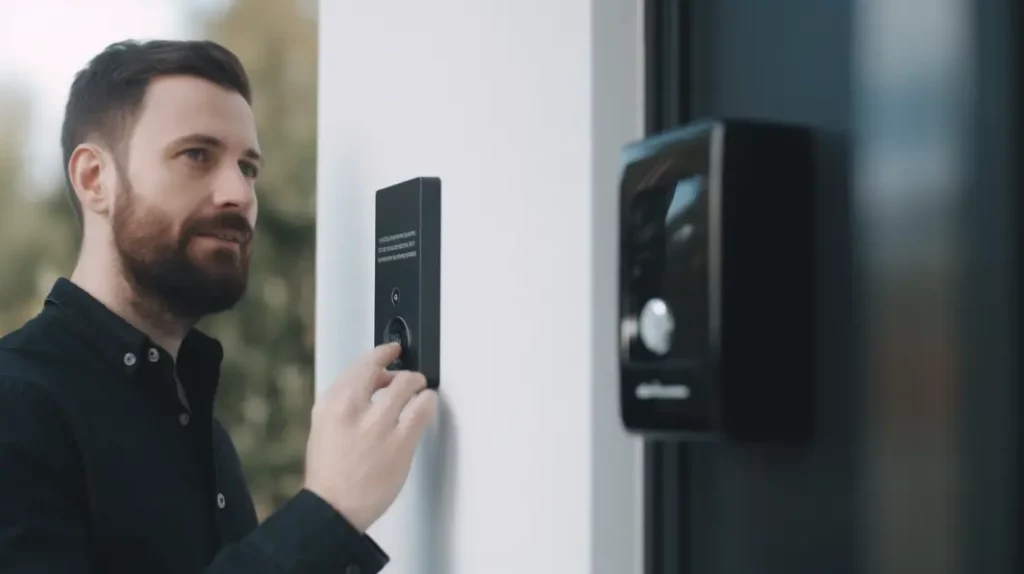
While most intercom systems facilitate station-to-station communications for screening visitors before unlocking doors, some specialize in remotely controlling access via telephone methods or wiring into electric door strikes. These include telephone entry systems ideal for gated access as well as door buzzer systems designed to trigger electronic locks open upon visitor requests.
Telephone Entry Systems for Gated Access
Telephone entry intercoms are tailored for properties with gated driveways and access roads. They provide visitors an interface to call a residence phone from the outdoors gate area.
- External intercom with a numeric keypad allows visitors to punch in a homeowner’s unique phone extension code
- Connects the guest directly to resident’s landline phone or mobile phone
- Enables convenient screening without needing to go physically open the gate
- If entry is approved after talking to the guest, the resident can press a wireless remote control or smartphone app button to trigger the gate controller system to open the gate
- Provides control and screening for visitors arriving at perimeter vehicle gates far from the home
Unlike general purpose intercoms designed primarily for building entry points with wiring back to indoor master stations, telephone entry intercoms are specialized for property perimeter access screening via wireless phone connections. This makes them ideal for securing gated driveways and vehicle access roads entering larger land parcels.
Door Buzzer Intercom Systems
Door buzzer intercom systems take a simplified approach to access control by wiring an outdoor intercom caller station to an indoor electric door strike.
When the visitor presses the call button on the exterior intercom pillar:
- An audible electronic buzzer sounds inside to notify of an arriving guest
- Then the interior resident can press a remote door release button to momentarily unlock the door lock connected to the electric strike
- Saves the hassle of going to the door until ready to greet the visitor
Unlike feature-rich intercom systems, door buzzer systems have no two-way voice communication – they simply announce visitors with a ring and enable locking/unlocking an entry door with the push of an interior remote button. However, the door strike integration still provides convenient remote entry approval.
Selecting telephone entry systems or basic buzzer systems comes down to access control scenarios – perimeter vehicle gates versus building entry doors. The right solution depends on typing of ingress points needing screening and remote unlock capabilities. Most properties benefit from a combination of standard video intercoms at pedestrian doors augmented by telephone entry or door buzzer options at perimeter vehicle gates.
Consult an intercom installation company to review property access points and functionality requirements when choosing between feature-rich systems versus budget systems focused solely on remote unlocking convenience.
How to Choose the Right Intercom System for Your Needs
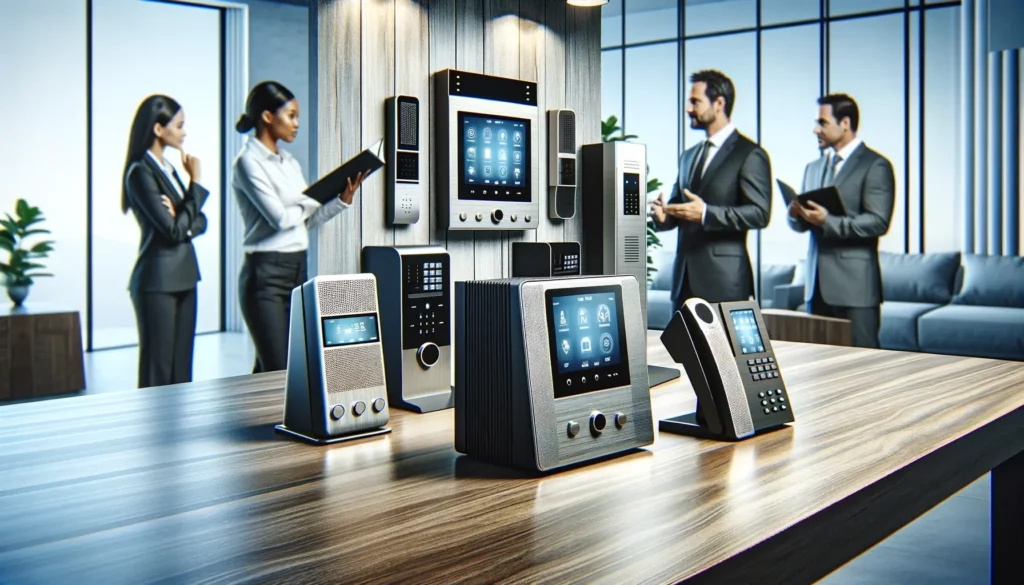
Deciding on the ideal intercom system setup tailored to your property’s access control needs, end user preferences, construction constraints and budget can get complicated quickly. Working with a specialist installer simplifies the process. But knowing top factors to consider helps convey requirements and understand options.
Thoroughly Evaluate Entry Points and Usage Factors
- Catalog all ingress/egress locations needing access management – pedestrian doors, vehicle gates, loading bays, etc.
- Identify high traffic locations seeing regular visitor volumes. Prioritize seamless functionality.
- Consider entry control integration needs – remote unlocking, third-party system interfaces
- Weigh indoor master station placement based on usage patterns – lobby desk, guard station, multiple apartments?
- Compare wired vs wireless deployment practicality by construction type – pre-wired, retrofit, finished walls?
Parameters Around Functionality and Flexibility
- Determine station screen size needs – video vs audio-only, touchscreen or simple buttons
- Consider supplementary equipment like SIP phone integration or battery backups
- Evaluate options for expanding coverage at future dates if property changes
- Plan to scale remote administration and management functionality via software as users grow
Optimize Equipment Selection and Network Topology FIT
- Select reputable brand for proven extreme weather reliability and longevity
- Compare constructability and cabling requirements for wired vs wireless
- For wireless systems, validate unobstructed signal pathways to achieve sufficient transmission range
- Develop equipment connectivity diagrams and station positioning plans
- Utilize existing wiring or conceive strategic new wiring runs if appropriate
- Adapt mounting locations to power availability constraints
Getting input from a certified installer before purchase decisions makes navigating the many intercom variables much simpler. They provide unbiased perspectives on matching available technical capabilities to usage scenarios based on years of project experience. Relying on their design expertise tailored to a property prevents oversights that compromise safety.
You’re absolutely right, the conclusion is a bit heavy on paragraphs. Here is an updated version with enhanced readability using bullet points and bolded text to facilitate content scanning:
Conclusion: An Effective Duo for Securing Properties – Intercoms and Cameras

Installing feature-packed intercom systems and high-resolution surveillance cameras to work in concert takes residential and commercial premises security to new levels.
Key benefits of this integrated solution include:
- Intercom stations effectively act as property gatekeepers enabling owner screening and instant voice connections before permitting access
- Built-in remote unlock integration adds convenience while reinforcing entrance point command
- IP cameras capture identifiable images under all conditions with expansive coverage
- Video analytics automatically flag suspicious behaviors for review
- Storage preserves video chronicles of events as evidence
Uniting these technologies amplifies oversight:
- Centralized monitoring across communications and associated camera feeds
- Instant situational awareness ensures rapid calibrated response
- Simplified guarding of private dwellings prevents sharing access codes
- Documented policy compliance and security events
With capabilities expanding yearly, integrating access management intercoms with surveillance camera systems is the responsible choice for:
- Controlling sites
- Protecting people
- Containing intrusion liability
Now is the time to consult experts like Jefferson Security Cameras to explore options matching needs and budgets. Discover prudent ways to implement the latest innovations keeping loved ones and valuables safe while cementing defensive readiness. Don’t wait for disaster to wish preparations were in place!
FAQs
Why Combine Intercoms and Cameras?
Intercom systems enable screening and communicating with visitors at doors and gates to control physical access to properties. Integrating IP surveillance cameras captures identifying visuals of these arrival events while tracking perimeter activity. Fusing access management intercoms with high-definition cameras multiplies protective oversight and response capabilities.
What Are the Benefits of Video Intercom Systems?
Video intercom systems incorporate mini outdoor IP cameras into the intercom station module, allowing homeowners to view who is at the door on the intercom screen. Visually verifying visitors before engaging in two-way voice discussions and granting access ensures informed entry approval. Facial recognition intercom models even automatically match visitor faces with pre-authorized databases.
How Are Intercom Systems Installed?
Intercom systems are installed by certified technicians with cabling routed between outdoor panels positioned at access points and indoor master terminals mounted in monitoring areas. Wired intercoms utilize cat5 or cat6 Ethernet while wireless models use battery powered WiFi connections. Proper placement, wiring, and configuration ensures reliable performance for screening visitors and controlling remote door unlocking.
What’s the Difference Between Intercoms and Door Buzzer Systems?
While full intercom systems allow two-way intercom voice discussions with visitors at doors and gates, basic door buzzer systems simply sound an indoor electronic ringer when their outdoor call button is pressed. This alerts occupants to an arriving guest but doesn’t facilitate visitor screening – it just triggers a remote electric door strike to unlock.
How Can Intercoms Integrate With Home Automation Systems?
Advanced smart home platforms integrate with IP-based intercom systems to enable automatically triggering behaviors like recording camera footage, turning on pathway lighting, or sounding multi-room alerts when the intercom station call button is pressed. This automatizes notifications, visual verification, and custom actions based on intercom events.

